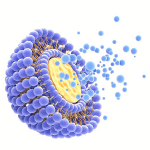 Liposomal delivery systems, with their advanced nutrient bioavailability, are becoming more popular. There are over 65,000 peer reviewed published studies on Liposomal delivery. They are utilized in medicine for the delivery of vaccines, hormones, enzymes, vitamins and botanicals.
Liposomal delivery systems, with their advanced nutrient bioavailability, are becoming more popular. There are over 65,000 peer reviewed published studies on Liposomal delivery. They are utilized in medicine for the delivery of vaccines, hormones, enzymes, vitamins and botanicals.
Liposomes are tiny lipid bubbles about the width of a single human hair. They are made out of the same type of fat as our own cell membranes called phospholipids. Liposomes are stable, and can carry both water and fat-soluble nutrients. When formulated correctly, they can facilitate absorption as soon as they land on the tongue, and can help protect breakdown by digestive acids, enzymes and first pass thtrough the liver. Because they are made of the same lipids that compose our own cell membranes, they may assist nutrients to gain access into the cell membrane and optimize cellular support.
Liposomal technology like suppository has been said to provide the power of intravenous therapy. Because of enhanced delivery and absorption, nutrients delivered in liposomal form at lower doses may offer equal or greater efficacy than higher doses provided in forms that are less bioavailable.[8],[9]
Their potency is impressive. In liposomal form, the absorption of glutathione can compare to that of intravenous formulations, and appears to help maintain intracellular storage.[10],[11] Even better, the phospholipids in liposomes are therapeutic. They help nourish every cell membrane by providing the lipids needed to function optimally and flush out toxins that accumulate there.
Advanced Ultra-Nano Liposomal Formulations Are More Effective
Not all liposomes are alike. The technology used to manufacture them, as well as their size, can vary considerably.
Liposomes are emulsions, but not all emulsions can become a liposomes. Liposomes are specific ‘vesicles’ or bubbles modified to carry either fat-soluble or water soluble molecules. Their likeness to living bi-layer lipid cell membranes is remarkable. If a vitamin or nutrient is placed inside the liposome, it will not readily pass through the bilayer. When the liposome merges with the lipid bilayer of the cell membrane, it can deliver its contents directly to the cell.
The size of a liposome—smaller sizes have been shown to offer dramatically higher uptake such as with our Ultra-Nano. That’s because the tiniest vesicles can be dramatically more efficient at cellular delivery of encapsulated nutraceuticals. In one notable study, cellular uptake increased 9-fold as liposome size dropped from 236 nm to 97 nm. At the smallest size of 64 nm, the uptake was 34-fold higher.[13]
Beyond Liposomes: Ultra-Nano
Particles at this incredibly tiny size are so small that they are even smaller than wavelengths of visible light. They are crafted using modern technology and high level equipment.
References
[1]Olthof MR, Hollman PC, et al. Bioavailabilities of quercetin-3-glucoside and quercetin-4′-glucoside do not differ in humans. J Nutr, 2000 May;130(5):1200-3. View Abstract
[2]Seeram NP, Lee R, Heber D. Bioavailability of ellagic acid in human plasma after consumption of ellagitannins from pomegranate (Punica granatum L.) juice. Clin Chim Acta, 2004 Oct;348(1-2):63-8. View Abstract
[3]Manach C, Williamson G, Morand C, et al. Bioavailability and bioefficacy of polyphenols in humans. Review of 97 bioavailability studies. Am J Clin Nutr, 2005 Jan;81(1 Suppl):230S-42S. View Abstract
[4]Xu JZ, Yeung SY, Chang Q, et al. Comparison of antioxidant activity and bioavailability of tea epicatechins with their epimers. Br J Nutr, 2004 Jun;91(6):873-81. View Abstract
[5]Nieves CJ, Montero C et al. Bioavailability of Herbs and Spices. The FASEB Journal 2009;23:1_supplement, 718.13 View Abstract
[6]Emami S, Azadmard-Damirchi S et al. Liposomes as carrier vehicles for functional compounds in food sector, Journal of Experimental Nanoscience. 2016.11:9, 737-759. View Full Paper
[7] Taylor TM, Weiss J et al. Liposomal nanocapsules in food science and agriculture. Crit Rev Food Sci Nutr. 2005;45:587–605 View Full Paper
[8]Silva AC, Santos D, et al. Lipid-based nanocarriers as an alternative for oral delivery of poorly water-soluble drugs: Peroral and mucosal routes. Curr Med Chem. 2012;19(26):4495-4510. View Abstract
[9]Rogers JA, Anderson KE. The potential of liposomes in oral drug delivery. Crit Rev Ther Drug Carrier Syst. 1998;15(5):421-480. View Abstract
[10]Levitskaia TG, Morris JE. Aminothiol receptors for decorporation of intravenously administered (60)Co in the rat. Health Phys. 2010 Jan;98(1):53-60. View Full Paper
[11]Zeevalk GD, Bernard LP Liposomal-glutathione provides maintenance of intracellular glutathione and neuroprotection in mesencephalic neuronal cells. Neurochem Res. 2010 Oct;35(10):1575-87. View Abstract
[12] Unpublished study on Caco-2 intestinal cells by Quicksilver Scientific,
[13] Hood RR, Andar A, et al. Pharmacy-on-a-chip: Microfluidic synthesis of pegylated and folate receptor-targeted liposomes for drug delivery. 16th International Conference on Miniaturized Systems for Chemistry and Life Sciencies. 2012. Okinawa, Japan.
[14]Alexander-Bryant AA, Wen X. Bioengineering Strategies for Designing Targeted Cancer Therapies. In: Advances in Cancer Research, 2013 View Abstract
[15]Smith ME, Morton DG. Digestion And Absorption. In: The Digestive System (Second Edition), 2010
[16] Bawa R. Nanoparticle-based therapeutics in humans: A Survey. Nanotech L&B ,2008;5 : 135–155
[17]Kedar U et al. Advances in polymeric micelles for drug delivery and tumor targeting. Nanomedicine, 6 (6) (2010), pp. 714-729
[18]Shoji Y, Nakashima H. Nutraceutics and delivery systems. J Drug Target, 2004;12(6):385-91.
 Liposomal delivery systems, with their advanced nutrient bioavailability, are becoming more popular. There are over 65,000 peer reviewed published studies on Liposomal delivery. They are utilized in medicine for the delivery of vaccines, hormones, enzymes, vitamins and botanicals.
Liposomal delivery systems, with their advanced nutrient bioavailability, are becoming more popular. There are over 65,000 peer reviewed published studies on Liposomal delivery. They are utilized in medicine for the delivery of vaccines, hormones, enzymes, vitamins and botanicals.